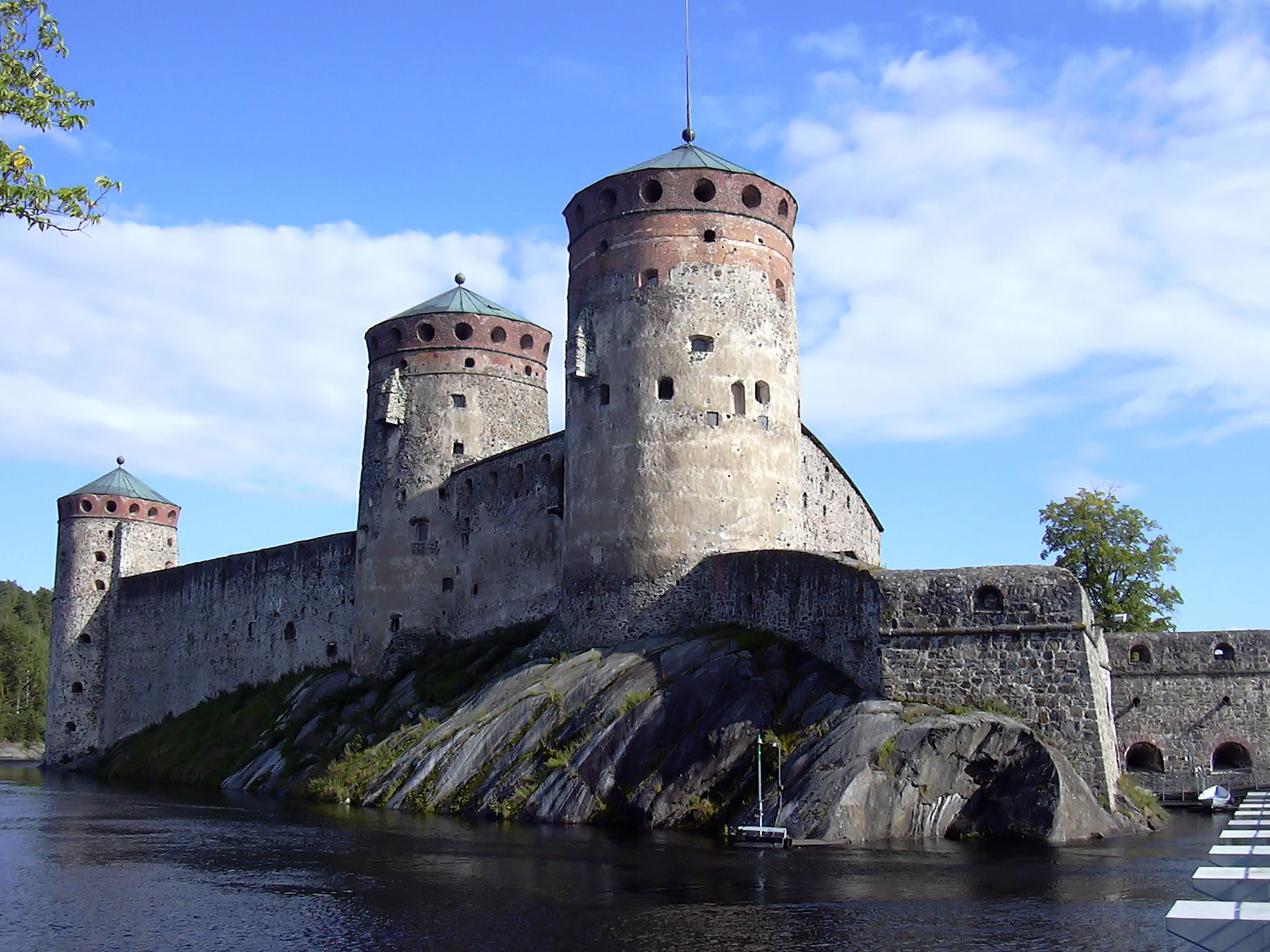Olavinlinna (Swedish: "Olofsborg") or
St. Olaf's Castle is a 15th century castle located on a rocky island between the
lakes Haapavesi and Pihlajavesi connected to the Bay of Lake Saimaa in northern
Finland in Savonlinna Provincial Cham.
 |
| Attribution: Miraceti, License |
Construction of the
castle was begun in 1475 by the Danish Knight Erik Axelsson Tott, who had
engaged in strengthening the Vyborg Castle. Erik Axelsson Tott decided that the
powerful fortification should be build to protect the strategically important
Savo region. The castle was supposed to repel Russian attacks from the east and
to guarantee the control of the Savo region for the Swedish Crown. Initially,
the castle was named Nyslott (Swedish:
New Castle), then it was named Olavinlinna, Castle of St. Olaf, in honor of the
Catholic saint of the 11th century, especially in Scandinavia revered as the
patron saint of the Knights.
The first castle was
built of wood, but two years later it was demolished and construction began on
a new, stone castle. Resistance of the local population to the construction of
Swedish castle in this region was so great that the construction was carried
out under the strong Swedish convoy. One of Tott's letters from 1477 includes a
passing mention of foreign builders invited to Olofsborg, probably from Reval,
where the city fortifications were being extended. Construction of the castle continued
until the end of the 15th century. It was the first Swedish castle provided
with a set of thickset circular towers that could withstand cannon fire. The
castle was built on a lake, in the middle of the intricate network of
reservoirs and canals that would seriously impede siege and offensive.
Name: Olavinlinna
Location: Savonlinna
Region: Southern Savonia
Country: Finland
Material: Brick
Construction: 15th century
Condition: opened to the public
|
After the release of
the Swedish Kalmar Union fortress remained in the hands of the Swedes. Over
time, the settlement grew around the castle, which was called Savonlinna. A
brisk trade developed under the umbrella of the castle was good, and in 1639,
the settlement became a town.
During the Northern War
Olavinlinna Castle was one of the main obstacles to the Russian troops deep
into Sweden. Despite this, 28 July 1714 Olavinlinna garrison capitulated to the
invading Russians. In 1721, under the terms of the Nishtadt peace treaty castle was returned to Sweden. The border of
the newly was passed at the same distance from Olavinlinna as it was before
Stolbovski peace treaty in 1617.
During a regular
Russian-Swedish War (1741-1743) Russian troops August, 6, 1742 again approached
Olavinlinna. Garrison of the castle consisted of only a hundred people and
within two days to surrender. In 1743 was signed Treaty of Åbo, which awarded
Olavinlinna along with the entire region Savonlinna to Empress Elizabeth of
Russia and it remained in her possession until 1917. At that time, the castle was named by the
Russian name Olafsborg.
In the end of 18th
century, the castle was the formidable fortifications in northern Finland. When
relations between Russian and Sweden became strained, Fieldmarshal Alexander
Suvorov came to the castle. Under his leadership, was carried further
strengthen the fortifications of the castle. Were built new bastions and
demolished several buildings, which crumbled of time and war.
In the
19th century the castle lost its military purpose, when in 1809 the whole
Finland became part of the Russian Empire. In 1847, the garrison left
Olafsborg. For a while there was a prison in the castle, but in 1859 it was
closed and the castle was abandoned. In the 1860's the castle was two fires, in
1870, it was renovated with funds from the treasury of the city, after which it
was opened to tourists. The castle was stronger reconstructed in 1961-1975
years. |
| Attribution:Lauri Kosonen Miraceti, License |
Today, the castle has
three towers connected by walls. Bell tower got its name from the church bells
and the castle clock, which had been installed on it. On the third floor of the
second tower Church was located a church. In a small house near the tower, is
located the entrance to the castle dungeon. Here, during the Swedish government
were kept state criminals. The third tower is the tower Keel. It got its name
from the name of the owner of the castle Keel, under leadership of which it was
erected. Later, after moving the fortress to the Russian was built in the south-east
corner of the fortress bastion Dick. It has three floors, on two of which were
located iron cannons.
Currently, the castle
is available for visitors all year round. It hosts several small exhibitions,
including the Castle Museum which displays artifacts found in the castle or
related to it, and the Orthodox Museum which displays icons and other religious
artifacts both from Finland and Russia. The castle forms a spectacular stage
for the Savonlinna Opera Festival, held annually in the summer since 1912.
In the preparation of
this article, were mainly used materials of websites: www.wikipedia.org, www.nba.fi/en/museums/olavinlinna_castle and http://sw-zamki.narod.ru/olavinlinna.htm

nice.. Id like to visit there..
ReplyDeletewant to know how to register in PTC sites go to.
www.registrationinptcsites.blogspot.in
Great place, I would like to walk in my brand new Nike Trainers i got from http://www.easyhits4u.com/customsplash/56169/
ReplyDeleteVery nice castle
ReplyDeletelifoogy.blogspot.com
whoinventedtelevision.blogspot.com
nice and visit: http://www.bdattractions.blogspot.com
ReplyDeletenice and visit: http://www.bdattractions.blogspot.com
ReplyDelete